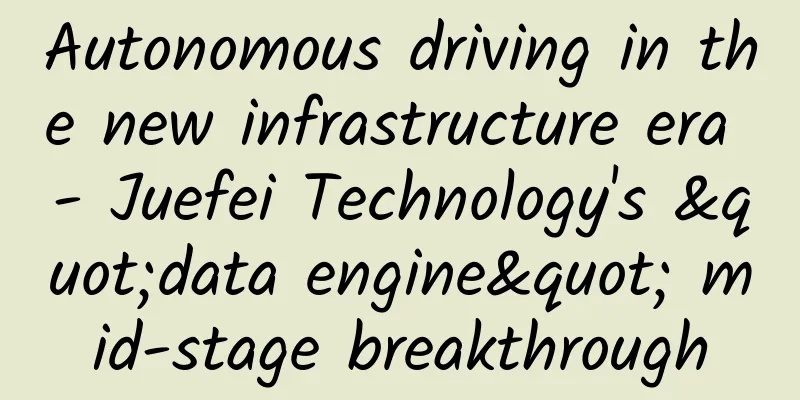Autonomous driving in the new infrastructure era - Juefei Technology's "data engine" mid-stage breakthrough

|
Preface: There is no shortage of new car-making forces in the industry. What is lacking are gold diggers who can define and rewrite the automotive industry with software. At the end of February 2020, 11 ministries and commissions jointly issued the "Intelligent Vehicle Innovation and Development Strategy", marking the official establishment of the direction of coordinated development of "vehicle-road-cloud" for China's intelligent connected vehicles, and drawing a clear track for China's autonomous driving. On this track, Juefei Technology chose to start with data to open up the "Ren and Du Meridians" of the industry. The smart driving "data engine" that best fits China's "vehicle-road-cloud" collaborative development path The sudden outbreak of the epidemic has made people discover another possibility of autonomous driving. Transporting materials, delivering goods, cleaning and disinfection... Combining autonomous driving technology with many practical scenarios has given rise to more urgent market demands. Are there more mature solutions for automotive intelligence? How can urban roads become smarter? How can the decision-making of the traffic cloud platform be more accurate? By creating a new generation of LBS data engine, Juefei Technology's goal is to truly realize the implementation of the "vehicle-road-cloud" model in the autonomous driving industry. Juefei Technology has a large amount of unstructured and highly discrete LBS data, including new sensor data, traffic and road administration data, travel operation data, high-precision natural world data, vehicle computing unit operation data, roadside perception data, etc. Starting from these data, through fusion calculations based on high-precision maps, we can reorganize the data for roads and vehicles. By combining the edge and cloud deployment at the bottom layer, we can productize and output various intelligent driving solutions for vehicles, roads, and cloud-controlled traffic brains, so that the "vehicle-road-cloud" collaborative model can play its true value. The "data engine" combines knowledge-driven and data-driven, providing corresponding fusion perception and planning modules, which can effectively ensure the safety of autonomous driving vehicles and the large-scale expansion of ODD, creating prerequisites for product output, while reducing the constraints of computing power and cost on implementation. The technical route adopted by Juefei Technology is to integrate and calculate real-time sensor data with high-precision map data to achieve a more stable and reliable perception and positioning engine, and use low-computing hardware to achieve high-level autonomous driving, which greatly broadens the scenarios and scope of autonomous driving technology in the market. The engine will help cars achieve intelligent driving, provide technical support for the construction of smart cities, and further contribute to the construction of cloud-based traffic brains as data accumulates. After the "data engine" entered the market, it solved many pain points in the autonomous driving industry. For example, it achieved sub-meter positioning through the integration of visual technology and high-precision maps, and can adapt to various working conditions without relying on lidar and complex sensors, truly achieving a higher level of autonomous driving with lower computing power of the terminal. For OEMs, every increase in cost is bound to have far-reaching impacts. It is precisely because the data engine has freed up the requirements for computing power that the R&D costs of autonomous driving can be reduced accordingly, providing OEMs with greater profit margins. With more accurate data, safer and more reliable solutions, and faster implementation, Juefei Technology's "data engine" is most in line with the development path of the "vehicle-road-cloud" collaborative era of autonomous driving. Middle platform model: From Data to Value On April 20, the National Development and Reform Commission clarified the scope of new infrastructure for the first time, emphasizing concepts such as data centers and intelligent transportation infrastructure. How to make data more efficient? Juefei Technology's approach is to use data engines to create a middle platform model to respond to the market. If the data engine solves the problem of "what data is there", then the middle platform model is to solve the problem of "how data evolves into products", that is, "how data serves the market". For autonomous driving companies themselves, the middle platform model is completely business-oriented and does not rely on the customer's own data. It allows developers who do not have data capabilities to focus on the product itself, and the development of autonomous driving algorithms such as vehicle control, perception, decision-making, and positioning can be carried out simultaneously with data development, ensuring that standards, timeliness, and efficiency are guaranteed in the process of using data, with higher stability and reliability. This will improve R&D efficiency and effectiveness and allow data to create greater value. On the one hand, Juefei Technology aims at the landing scene end, and through high-precision digital formatting capabilities, it empowers scenes with great potential for autonomous driving technology, such as mining areas, ports, and terminal delivery. On the other hand, for smart terminals, it effectively synchronizes and integrates sensor data from commercial and passenger vehicles, road sensor data, and high-precision map data in time and space, decouples from the underlying hardware, combines knowledge-driven with data-driven, and provides reliable and accurate intelligent solutions that can effectively ensure the safety of autonomous driving vehicles and reduce the requirements for computing power and costs. Because it connects the data of "vehicle, road and cloud", the middle-office model provides digital basic capabilities for landing scenarios and smart terminals from a business level, drives the implementation and scale of the intelligent driving industry, and truly realizes "From Data to Value". Rapidly implement the industry and enter the fast lane of autonomous driving development The "Key Points for Intelligent Connected Vehicle Standardization Work in 2020" issued by the Ministry of Industry and Information Technology in April clearly pointed out that one of the work priorities in 2020 is to form a standard system for intelligent connected vehicles that can support driving assistance and low-level autonomous driving, and provide basic guarantees for achieving the second phase of the construction goal of the standard system supporting high-level autonomous driving. Based on the rich experience in "data engine" and "middle-office model", Juefei Technology has formed a product matrix with the advantages of "cross-platform, easy to deploy, low power consumption, safe and reliable", and has reached cooperation with multiple institutions in the industrial chain to provide technical support for the development of autonomous driving from multiple levels such as data, terminals, and new infrastructure. At present, Juefei Technology has cooperated with industry partners such as Yutong Bus, Huawei, China Mobile, and the School of Vehicle and Transportation Engineering of Tsinghua University to jointly promote the mass production and implementation of the "car-road-cloud" model. At the same time, it actively cooperates with important players in China's intelligent driving industry to create value chain collaboration and service integration. It has become a member of the ARM Artificial Intelligence Ecosystem Alliance, a member of the China Mobile 5G Precision Positioning Alliance, a member of the Microsoft Accelerator, and has joined the NVIDIA Startup Accelerator Program. In the market, new demands and new scenarios are constantly emerging; the introduction of policies also points out the direction for industry development, and industry standards are gradually becoming clearer; on the technical side, 5G technology has become a new direction for the development of autonomous driving. Juefei Technology's idea of using data to lead autonomous driving innovation will also be verified in market competition. As a winner of Toutiao's Qingyun Plan and Baijiahao's Bai+ Plan, the 2019 Baidu Digital Author of the Year, the Baijiahao's Most Popular Author in the Technology Field, the 2019 Sogou Technology and Culture Author, and the 2021 Baijiahao Quarterly Influential Creator, he has won many awards, including the 2013 Sohu Best Industry Media Person, the 2015 China New Media Entrepreneurship Competition Beijing Third Place, the 2015 Guangmang Experience Award, the 2015 China New Media Entrepreneurship Competition Finals Third Place, and the 2018 Baidu Dynamic Annual Powerful Celebrity. |
<<: When will the cell phone “bombs” end?
>>: Apple is stepping down from the throne, will the mobile phone industry enter the domestic era?
Recommend
Dreaming about Zhongshan: Migrating to the West
…In 1937, when the Anti-Japanese War broke out, o...
How to optimize information flow advertising accounts?
As we all know, information flow advertising is t...
CTO Training Camp: A practical open class that won’t say goodbye
[51CTO.com original article] On December 3, 2016,...
Yutu visits the "Dragon's Back" "Yutu-2 Driving Diary"
Although the back of the moon is vast, there are ...
Millions of IPs create science and technology talents to strengthen the country丨China's aerospace industry lights up the road to exploring the universe
Exploring the mysteries of the universe has been ...
iPhone 6/6 Plus Chinese version on sale day rush to buy guide
One month after the first batch of iPhones were r...
How to find deleted WeChat payment records? Official tips
Nowadays, mobile payment has become the norm when...
From direct drive to essence washing, Haier washing machines create a "consumption trend"
Washing machines are a traditional category in th...
Fan Deng: Decoding the advanced code of spiritual growth
Fan Deng: Decoding the advanced code of spiritual...
What are the advantages and disadvantages of Wancibaping promotion?
Presumably, many friends who are engaged in onlin...
Viable business models for live streaming products: I have summarized 13
Judging from user behavior, the common live broad...
Mantou New Media Operation Video Course
Course Description A millionaire trader will teac...
Is 100 million enough? Comparing chips and configurations, do mobile phone manufacturers still have a "pixel" card?
Jobs said, "The focus on high pixels in mobi...
How to use scroll offset of ScrollView in SwiftUI
Preface Now that WWDC 24 is over, I decided to st...









